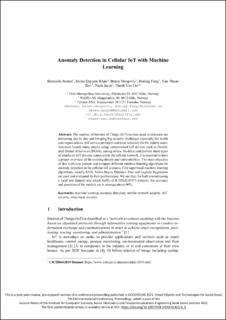| dc.contributor.author | Santos, Bernardo | |
| dc.contributor.author | Khan, Imran Qayyrm | |
| dc.contributor.author | Dzogovic, Bruno | |
| dc.contributor.author | Feng, Boning | |
| dc.contributor.author | Do, Thuan Van | |
| dc.contributor.author | Jacot, Niels | |
| dc.contributor.author | Do, van Thanh | |
| dc.date.accessioned | 2022-02-22T09:11:25Z | |
| dc.date.available | 2022-02-22T09:11:25Z | |
| dc.date.created | 2021-12-06T19:22:56Z | |
| dc.date.issued | 2021-01-01 | |
| dc.identifier.isbn | 978-3-030-91420-2 | |
| dc.identifier.isbn | 978-3-030-91421-9 | |
| dc.identifier.issn | 1867-8211 | |
| dc.identifier.issn | 1867-822X | |
| dc.identifier.uri | https://hdl.handle.net/11250/2980706 | |
| dc.description.abstract | The number of Internet of Things (IoT) devices used in eldercare are increasing day by day and bringing big security challenges especially for health care organizations, IoT service providers and most seriously for the elderly users. Attackers launch many attacks using compromised IoT devices such as Distributed Denial of Services (DDoS), among others. To detect and prevent these types of attacks on IoT devices connected to the cellular network, it is essential to have a proper overview of the existing threats and vulnerabilities. The main objective of this work is to present and compare different machine learning algorithms for anomaly detection in the cellular IoT scenario. Five supervised machine learning algorithms, namely KNN, Naïve Bayes, Decision Tree and Logistic Regression are used and evaluated by their performance. We see that, for both normal (using a local test dataset) and attack traffic (CICDDoS20191) datasets, the accuracy and precision of the models are in average above 90%. | en_US |
| dc.description.sponsorship | This paper is a result of the H2020 Concordia project (https://www.concordia-h2020.eu) which has received funding from the EU H2020 programme under grant agreement No 830927. | en_US |
| dc.language.iso | eng | en_US |
| dc.publisher | Springer | en_US |
| dc.relation.ispartof | Smart Objects and Technologies for Social Good: 7th EAI International Conference, GOODTECHS 2021, Virtual Event, September 15–17, 2021, Proceedings | |
| dc.relation.ispartofseries | Lecture Notes of the Institute for Computer Sciences, Social Informatics and Telecommunications Engineering;Volume 401 | |
| dc.subject | Machine learning | en_US |
| dc.subject | Anomaly detection | en_US |
| dc.subject | Mobile network security | en_US |
| dc.subject | IoT security | en_US |
| dc.subject | Cross layer security | en_US |
| dc.title | Anomaly Detection in Cellular IoT with Machine Learning | en_US |
| dc.type | Conference object | en_US |
| dc.description.version | acceptedVersion | en_US |
| cristin.ispublished | true | |
| cristin.fulltext | preprint | |
| cristin.qualitycode | 1 | |
| dc.identifier.doi | https://doi.org/10.1007/978-3-030-91421-9_5 | |
| dc.identifier.cristin | 1965296 | |
| dc.source.journal | Lecture Notes of the Institute for Computer Sciences, Social Informatics and Telecommunications Engineering | en_US |
| dc.source.volume | 401 | en_US |
| dc.source.pagenumber | 14 | en_US |
| dc.relation.project | EC/H2020/830927 | en_US |
